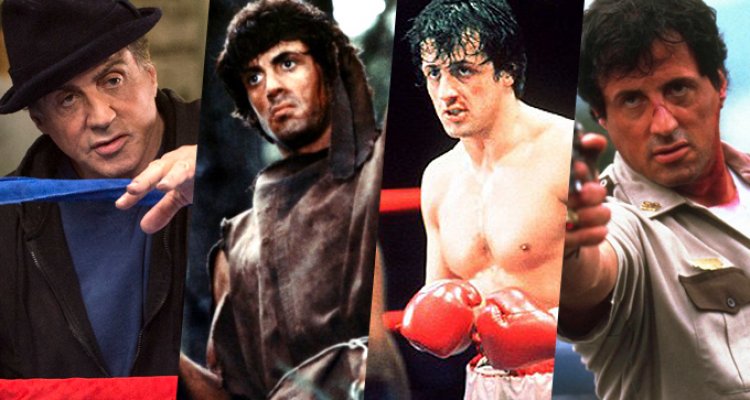“First Blood” (1982)
If there wasn’t a Rocky, there’d be a Rambo, and Stallone would’ve still found his way into conversations about Hollywood’s greatest silver-screen entertainers. The project went through a who’s-who of leading actors, including Clint Eastwood, Robert De Niro, Paul Newman, Steve McQueen, and Al Pacino, before it landed with Stallone — and just imagine how different the whole thing would’ve been if any of those other guys portrayed John Rambo. No, it’s not really all that imaginable because Stallone brought his fevered determinism, raw capacity for hurling himself into all sorts of action, and bottled sensitivity to become the face, voice, and hairy presence of the Vietnam vet and Green Beret badass. Mandatory viewing in many homes, and a staple of many childhoods reared in the ’80s (mine included), “First Blood” introduced the world to a misunderstood and soft-spoken Rambo (Stallone), whose spasms of PTSD reach breaking point after he runs into a corrupt police force. The leader of said local police station, Teasle (Brian Dennehy), becomes obsessed with catching Rambo after the man escapes from custody and police brutality. Jack Starrett (and his unforgettably booming voice-box) turns in a memorable performance as the even more crazed cop Art Galt, and Richard Crenna‘s Trautman, the man responsible for molding Rambo into a dehumanized killing machine, handles some of the script’s greatest lines with appropriate gusto, including a sensational description of Rambo as a man who’d “eat things that a billy goat would puke!” “First Blood” is a head above all the sequels it spawned in terms of execution and characterization, including a final and very emotional breakdown in front of Trautman that clearly marks one of Stallone’s highest acting triumphs.
“Cobra” (1986)
Before the decade was over, and before the system began its failed attempt to market Sly Stallone as a comedic force (like with the dire “Stop! Or My Mom Will Shoot“), the ’80s would bear fruit to what could be the most memorable so-bad-it’s-good Stallone action vehicle. Written by Stallone, “Cobra” follows an LAPD Zombie-Squad officer used as a last resort by regular cops who can’t handle the intensity of the job. Wearing airtight jeans and a black V-neck, sporting signature Aviator sunglasses, chewing on a matchstick, driving around in a modified 1950 Mercury with license plates reading “AWSOM,” and cutting pizza with scissors like a fucking boss, Marion Cobretti (Stallone) was born to become Cobra. Just to put it into perspective, this project came about after Stallone resigned from working on “Beverly Hills Cop” because it was too comedic for his tastes. The result is a film that he might not have thought comedic on paper, but that’s become regarded as something of a cult classic partly due to the laughs it generates when it comes to the dialogue (please, “crime is a disease, and I’m the cure” isn’t the film’s tagline for no reason), the music (Robert Tepper‘s ‘Angel of the City’ number is allowed to play in full over an unforgettable montage featuring, among other things, a photo shoot with robot mannequins) and the bizarrely insane villains screaming about a New World Order. Brigitte Nielsen‘s Ingrid Knudsen becomes a target, and Cobra is assigned as her protector; the pair’s stoic acting styles complement each other in sizzling B-movie campiness. A magnet for the Razzies at the time, “Cobra” is beloved by many Stallone diehards and is famously praised by Nicolas Winding Refn. Re-watching it reminds you just how much of an inspiration it was for “Drive,” in terms of its neon-velvet aesthetics, wardrobe, and killer attitude.

“Cliffhanger” (1993)
Featured in our mountain-climbing feature as a “sublimely, gloriously stupid” piece of work, “capturing a time in American culture when Stallone wasn’t an over-the-hill action hero falling back on his ‘Rocky’/’Rambo’ mythologies to draw a crowd,” “Cliffhanger” is a favorite among Sly fans, and certainly one I remember immensely enjoying as a kid. John Lithgow‘s cantankerous villain Eric Qualen is one of the most immensely enjoyable foes from Stallone’s rogue gallery, and that unpredictable opening sequence featuring Michelle Joyner as the ill-fated Sarah packs enough of an emotional punch to last over the entire running time. Conveying that presence is Stallone’s Gabe Walker, who handles the memory and carries the guilt around with the kind of intensity that became the actor’s signature by the early ’90s. With multiple “Rambo” and “Rocky” sequels behind him, “Cliffhanger” was breath of fresh (mountain) air in terms of Stallone’s filmography, a film set in a rarely tested environment for action, and — according to Stallone himself — something of a comeback role after a few box-office duds. Gaining 20 pounds of muscle and pretending like he totally doesn’t have a fear of heights, Stallone’s Gabe is an ex-mountaineer conned into helping a troupe of nasty villains locate suitcases full of money. It’s unabashedly silly in plot, narrative, and all its efforts to tick every box of possible mountain deaths — including Stallone grabbing a villain’s balls and impaling him on a stalactite. Take all of that and add the physical theatrics and pure-hearted displays of heroism, and you’re obviously dealing with an essential Stallone picture.

